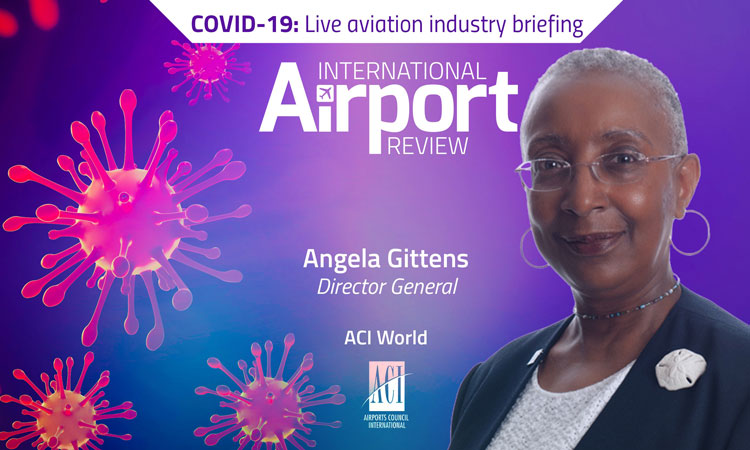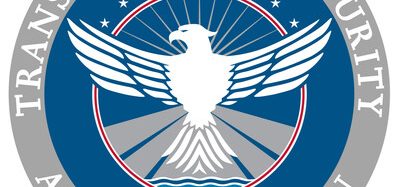Angela Gittens answers the aviation industry’s questions on COVID-19
- Like
- Digg
- Del
- Tumblr
- VKontakte
- Buffer
- Love This
- Odnoklassniki
- Meneame
- Blogger
- Amazon
- Yahoo Mail
- Gmail
- AOL
- Newsvine
- HackerNews
- Evernote
- MySpace
- Mail.ru
- Viadeo
- Line
- Comments
- Yummly
- SMS
- Viber
- Telegram
- Subscribe
- Skype
- Facebook Messenger
- Kakao
- LiveJournal
- Yammer
- Edgar
- Fintel
- Mix
- Instapaper
- Copy Link
Posted: 27 April 2020 | Angela Gittens - ACI World, Tara Nolan (International Airport Review) | No comments yet
Angela Gittens, Director General of ACI World, on the topic of COVID-19 and post-pandemic recovery, exclusively answers questions posed during a live industry briefing.


International Airport Review’s recent live industry briefing with ACI World’s Director General was the first in a series designed to ensure the aviation industry remains up to date in regard to the COVID-19 crisis.


A high volume of high-quality questions were received. Therefore, post briefing, Angela exclusively answered some of the industry queries.
What future measures can ACI suggest to fight this sort of pandemic condition?
While we cannot predict exactly how emergencies will unfold, we can prepare for a diverse set of scenarios. With respect to communicable diseases, ACI policy recommends that airports abide by international health regulations and include mitigation measures as part of their emergency preparedness.
Health screening and/or certification is likely to become the new normal. Many different solutions are being deployed, and further work is required to determine the most efficient and effective best practices. This may also be the time to consider solutions for truly autonomous, hands-free passenger self-processing throughout the journey.
Airports must have an aerodrome emergency plan which establishes the guidelines for how major emergencies will be managed and defines the roles and responsibilities of the principal responding agencies or teams.
Local, regional and national organisations and agencies – such as health providers, government agencies or emergency services providers – will also be involved in the response to any incident and must be factored into the development of the plan.
While the airport operators will normally have the primary responsibility for emergencies, they should call upon and use the collective expertise and resources of all airport community partners for the benefit of all.
Listen to Angela’s industry briefing and hear ACI World’s most recent figures and data on how aviation should battle the COVID-19 crisis.
Do you see airports revising their charges being levied on airlines to help them stand up in the post COVID-19 environment?
The aviation industry is an ecosystem and will need to recover in a balanced way which does not favour one part of the industry over another – we all need each other.
ACI favours market-based solutions between airports and airlines considering the fact that both are interrelated businesses with shared risks. Generally, airports want to work closely with their airline clients to incentivise the growth of traffic which is a mutual interest in the recovery period.
In the medium to long-term, national authorities will have a key role to play to stimulate air transport demand and foster a rapid recovery of the airport business. Restoring consumer confidence will be an important part of this effort.
This is especially important considering the substantial downward pressure on the global economy, declining incomes and high unemployment, translating into higher price sensitivity for air transport demand.
Is ACI identifying best practices for communicating with passengers/employees in regard to the new normal or airline operation return?
ACI World’s subject matter experts and programme leads have come together with the ACI regions to establish a pipeline of free support and information to assist members in navigating this period.
From advisory bulletins on key topics, to repackaged content from manuals and handbooks, and free webinars and podcasts, support has been focused on this overriding issue.
As the industry moves into recovery mode, the information and technical guidance that we package and provide will be tailored towards supporting these efforts. That is, moving from support in dealing with the crisis, to moving to support to aid the recovery process.
In fact, ACI World has just released a road map for the airport industry’s recovery in response to the COVID-19 pandemic. The Policy Brief – COVID-19: Relief Measures to Ensure the Survival of the Airport Industry – outlines exceptional measures to provide policymakers with a comprehensive toolkit of solutions to ensure that the airport industry can be sustained through the crisis and lay the foundation for recovery. This is available, free of charge, on the ACI World website.
If we are asking government to help, why not ask them to cover the agenda that aviation needs to cover with the reduction of carbon emissions? In other words, can we use this middle time for governments to fund work towards better understanding the challenges of lowering carbon emissions for air transport?
To deal with both crises (health and climate change) will require a great deal of planning, coordination and collaboration among different stakeholders.
Air transport actors, such as airports, will have more leverage for support from the government if they join efforts in actions to tackle climate change that could impact multiple stakeholders from within and without the sector. For example, the availability of renewable energy will be critical for airports to transition to a net-zero carbon business model. Stakeholders would have a stronger claim for support if airport operators work in collaboration with municipalities, communities and other business sectors that can benefit from government investment in renewables.
Working to identify innovative ways to collaborate and define new business models will be essential to the recovery of the sector and to overcoming the current challenges of lowering carbon emissions. We hope governments will further support the sector’s carbon reduction efforts by investing in research and development (R&D) to build more environmentally-friendly technology and scale up the commercial deployment of sustainable aviation fuels.
ACI will continue to work with the Air Transport Action Group (ATAG) to identify priorities and joint opportunities for the industry. Although we first need to get through the global health crisis, we also have the opportunity to rebuild a more resilient industry, including climate change as an essential element of our recovery plans.
We are pleased that ATAG is not losing sight of the climate change crisis, and nor are airports. ATAG is doing what ATAG does best: It is bringing together all parts of industry so that we have a joined up view of what the longer term future needs to look like so that the industry, regulators and travelling public can thrive.
Through a life briefing, Simon Hocquard, Director General of CANSO, provided a first look into CANSO’s new data-driven insights, and explored how the air traffic management (ATM) sector is working on contingency plans during the COVID-19 pandemic. Watch this session now!
Recovery will take time and surely investments will be put on hold in 2020. However, there is technology that will help the airports to spring back, such as self-service technology and contactless technology for passenger processing that will enable higher throughput of passengers in existent capacity, better passenger experience, reduce operational costs and reduce the spreading of pathogens. Are you advising the airports not to shy away from such investments in 2020 to collect the benefits in the near to long-term? How are airports seeing these investments – as a must have or are they forced to put them on hold until the financial situation stabilises?
During this global disruption airports have been forced to reconsider their normal business and operational processes, including the deployment of innovative technologies and solutions for self and autonomous operations.
For this reason, airports are considering what adjustments can be made for the post-COVID-19 environment that will be beneficial in the near to long-term.
For instance, health screening is likely to become the new normal. Many different solutions are being deployed and further work is required to determine the most efficient and effective best practices. This may also be the time to consider solutions for truly autonomous, hands-free passenger self-processing throughout the journey.
Today, airports are focused on business continuity, but they will soon be considering how to manage the business impact in preparation to accelerate the growth. These key topics will be covered in later advisory bulletins. ACI will release an advisory bulletin on this topic in the near future.
What do airports need in terms of assistance (short term, mid term, long term)?
The impact of COVID-19 on the airport sector has been profound. Passenger traffic is expected to decline by almost 40 per cent and revenue is expected to contract by $77 billion (U.S. Dollars) in 2020; a decline of 45 per cent. In order to alleviate this unprecedented impact, ACI World has issued the following six focused policy responses that should be implemented:
- Protection of airport charges and revenues: As airports will need to ensure the continuity of basic services, alleviating the collection of airport charges through suspension or blanket discounts is an ill-advised response
- Tax relief: Urgent tax relief will provide much-needed financial oxygen to airports to ensure continuity of operations and safeguard airport jobs
- Concession fee waiver: Airport rents and concession fees should be waived or postponed in the form of a one-time measure for a defined period
- Temporary suspension of slot usage requirements: Airport slot usage requirements should be suspended, at global level, until 30 June 2020 with a reassessment of the situation based on data-driven evidence to follow
- Continuity of air cargo operations: Airports should continue levying charges on air cargo operations to maintain essential airside and cargo facilities
- Comprehensive financial relief: This should include wage subsidy schemes to allow continued operations and a rapid return to full operations. Grants and subsidies, secured financing, loans at preferential rates and bank guarantees should be made available. Financial relief should be non-discriminatory and not benefit one actor at the expense of others in the aviation ecosystem.
Some airport facilities such as taxiways/runways could suffer from long time aircraft storage since those surfaces are not primarily intended for such storage. Will you issue some pragmatic recommendation about these facilities return to service such as Service Indexes and visual inspection?
Indeed, taxiway and runway pavements are not normally designed for parking and there is a concern about damage to pavements. ACI has released an advisory bulletin on Airside Safety and Operations under COVID-19 which addresses these issues. We recommend that airports make an assessment based on aircraft types and pavement rating and consider how to ensure pavements remain up to standard. Aircraft operators may seek to add ballast in their stored aircraft to ensure stability under wind conditions, therefore it is anticipated that flexible pavement may suffer from overloading. In case of damage, airports should consider that taxiways requiring repairs or re-surfacing could be out of service for some time, with attendant operational constraints.
Even when there is no damage, airports should give consideration as to how pavements should be re-certified once the aircraft are moved. We are seeking advice from aircraft manufacturers in this regard.


How will airports introduce social distancing in key areas, for example security and gate lounges?
For airport operators, the main aims are to protect the health and welfare of travellers, staff and the public, and to reduce the opportunities for further spread of the virus. Social distancing has been key to these efforts.
Airports have deployed social distancing at the workplace in that staff are assigned to workstations that are more spatially spread out or alternate with other departments.
Likewise, they have instilled measures such as stickers on the floor to encourage two metres distancing at all passenger touchpoints including arrivals, check in, passport control, security checkpoint and self-service gates. These measures are feasible at this time of low volume but cannot be a long-term solution once traffic approaches pre-COVID levels.
In your opinion, what – if any – collaborative approaches could contribute to mitigating the consequences of the COVID-19 crisis?
The development of the aviation industry is symbiotic and recovery will require collaboration and cooperation among all aviation stakeholders, including industry – airports, airlines, air navigation providers, manufacturers, etc.— regulators and governments.
In addition, the relief measures that have been put forward by ACI will ensure that financial assistance does not benefit one part of the industry over another in the aviation ecosystem, so that a balanced global recovery can be created.
For the future, ACI had already been working on developing guidance to improve airport resilience in the face of the effects of climate change and had already issued guidance on business continuity in the face of a range of circumstances. This crisis, being worldwide, with both physical and economic consequences, is closer to a world war scenario than either a health or economic catastrophe. It will be incumbent on a myriad of sectors to improve our global and local responsiveness to this kind of event. It may require the kind of global reflection that led to the establishment of ICAO.
Do you think we can still count on air traffic to double by 2037?
Most experts in the air transport industry agree that the prospective recovery may take two years to reach the pre-crisis traffic levels; we may not see pre-COVID-19 traffic volumes again before the end of 2021.
It’s very hard to predict at this point how long before the industry will bounce back and ACI will continue to periodically update the impact of COVID-19 on air traffic. The impact of the health crisis may very well have an impact on when air traffic will double.
As far as slots are concerned, have current slots for schedule services been put on hold and will airlines be able to automatically get their slots back when air services are resumed?
Airport slots usage requirements have been temporarily suspended until 30 June 2020 to enable carriers to adjust their schedules in a sustainable way and for airports to protect connecting traffic at hub airports and help safeguard connectivity worldwide.
As regards subsequent adjustments, ACI favours an ongoing flexible reassessment of the situation based on data-driven evidence that would focus on the situation in every market.
Because the released capacity can be used for cargo and freighter flights during the crisis, a time-limited approach could limit unintended consequences when the situation starts to return to normal. This will ensure that passenger carriers regain access to their slots rapidly when demand will warrant a return to operations.
Receiving realistic flight schedules enables airports to take necessary operational and planning measures, and to reduce operating costs proportionately. Therefore, ACI is urging airlines to return their slots within 24 hours of removing flights from booking systems and make commercial cancellations at the very latest two weeks before the scheduled departure date.
Along with the global temporary suspension, a high level of dialogue and close collaboration between carriers and airports is needed to better align the supply of airport capacity with the actual passenger demand.
Very few governments have shown support so far for airports. How long do you think it will take for governments to realise the importance of supporting airports and how will ACI react in order to make them move faster with their assistance?
We have seen examples of government assistance for airports. Canada is waiving ground lease rents from March 2020 through to December 2020 for the 21 airport authorities that pay rent to the federal government, providing relief of up to $331.4 million. Airports in the U.S. will be awarded approximately $10 billion in COVID-19 financial support under the CARES Act Airport Program. In Singapore and as part of the second assistance package in response to the COVID-19 outbreak, more than S$1 billion will be set aside for sectors such as aviation and tourism. Brazil has postponed concession fees.
ACI will continue to advocate for its recommended policy measures to help airports weather and recover from the crisis.
At this moment, does ACI see any recovery signs especially from regions like APAC?
States are starting to place attention on recovery. ACI is encouraging states to coordinate their planning based on recommendations from health authority criteria and practical measures in collaboration with industry. We are looking at short-medium and long-term measures as commercial aviation demand emerges. The recovery period will be affected by the length of time it takes for the virus to be considered contained in key markets and the depth and length of any economic recession caused by the lockdowns in many states.
The likely scenario is that domestic traffic will recover first so countries that have substantial proportions of such traffic and have a strong virus mitigation programme will see the earliest recovery. Conversely, countries that are highly dependent on international traffic and/or are not seen as having contained the virus, will be the last to recover.
Of course, the earlier the scientists and medical community can develop and scale up a vaccine or a reliable treatment regime, the faster the entire world will be able to recover.
Related topics
Aeronautical revenue, Airport crisis management, COVID-19, Economy, Regulation and Legislation

















